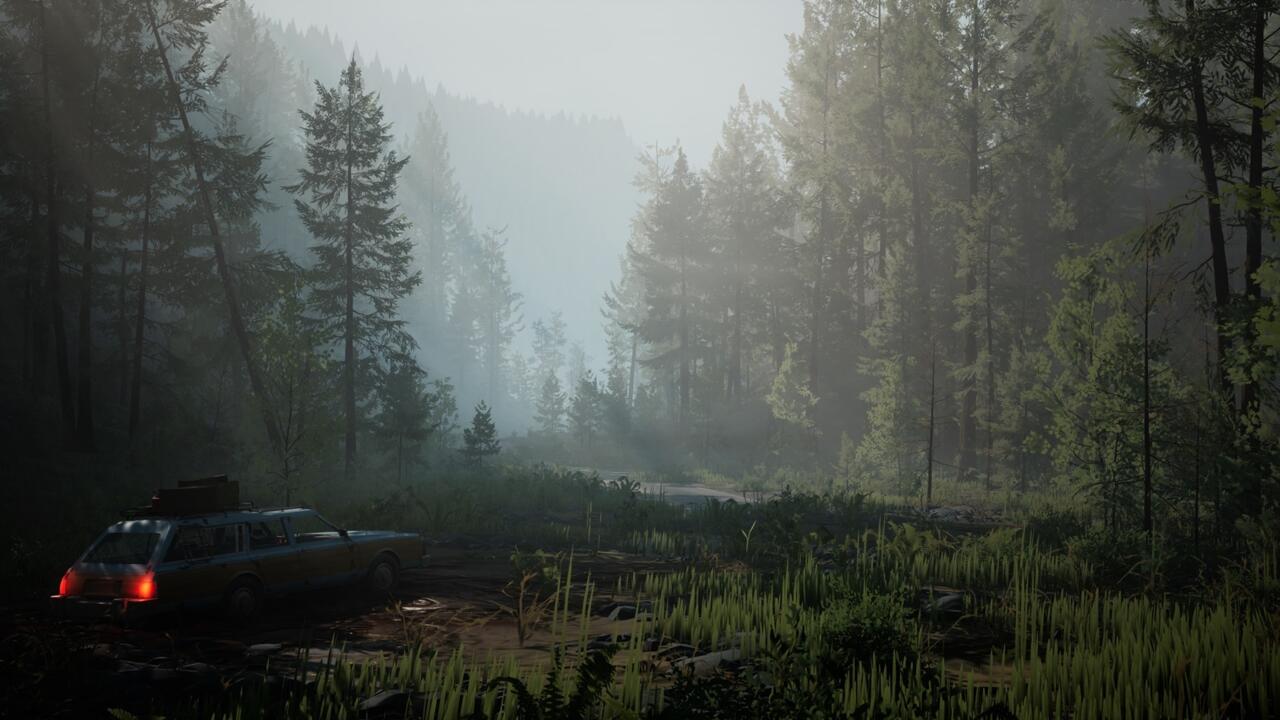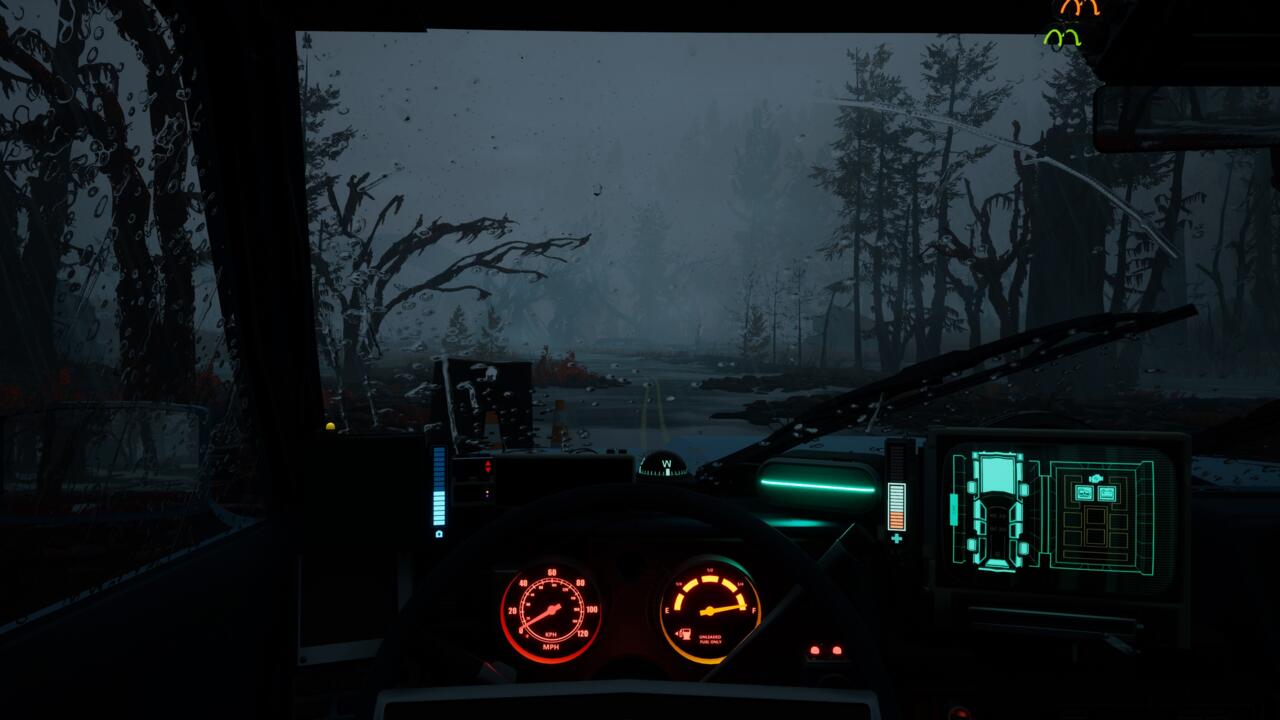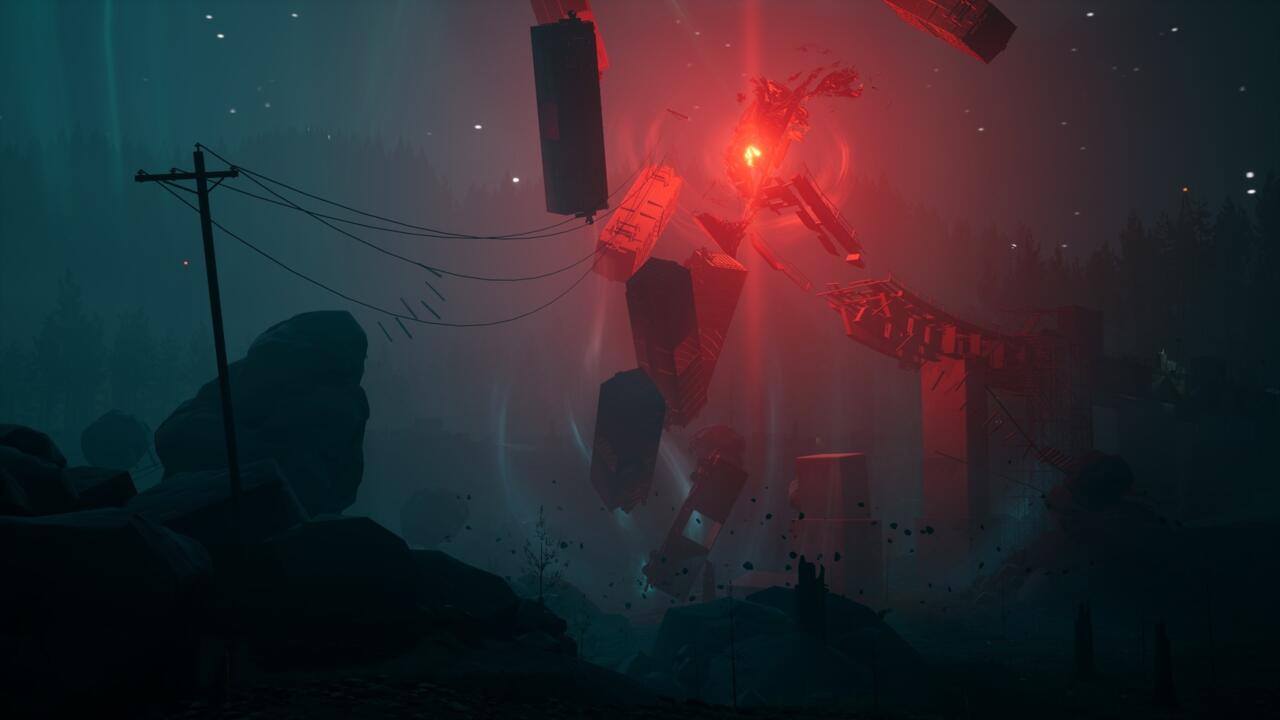In my personal life, I loathe driving, but video games have a way of making it more fun. Rarely does a video game make driving as engaging and enjoyable as Pacific Drive does, even though it can be much more challenging than any real-life drive I've ever taken. With a ton of gameplay depth, an intoxicating atmosphere, and a New Weird story I obsessed over, the debut game from Ironwood Studios dazzled me even though it occasionally left me stranded in the breakdown lane.
In both story and gameplay terms, I've not played a game much like Pacific Drive before. Stuck in a mysterious section of the Pacific Northwest called the Olympic Exclusion Zone (OEZ) that's been closed off for years due to science-defying activity, you're meant to find a way out of a region known to swallow almost anyone who enters it. You'll do this in roguelite runs in which you drive a station wagon through a semi-randomly generated level or series of levels, collect crafting gear and other vital resources, and then race against a storm to get to a spacetime-disrupting "gateway" that propels you back to the safety of an abandoned auto shop, where you'll deposit your resources and use them to improve your vehicle and character for subsequent runs.
For more than 20 hours, this formula never wore out its welcome with me, despite some truly grueling situations that sometimes felt insurmountable. By way of great attention to detail and depth, Pacific Drive becomes a challenge early on and consistently raises the bar even as you markedly improve your car. It feels like it unfolds--as do many roguelites--to the cadence of two steps forward, one step back.

You won't just have to worry about obvious car problems like flat tires, though they'll occur often in the early-game while your tires are no better than would-be spares. You'll need to ensure the car's body, like side panels and doors, are in good condition so that they may protect you from the often-irradiated OEZ. You'll need to be wary of the times when you get out of your car, as various hazards, like towers giving off jolts of electricity and hunks of metal that fly around like UFOs, are openly hostile to you. And as the game goes on, the list of these "anomalies," or enemy entities/events, only gets longer.
One fantastic element of these anomalies is their foreign designs and behaviors are so hard to decipher that it causes me to almost want to test them so I could better understand their nature and later know how to overcome them more wisely. But there's a simpler way: You can scan basically anything in the game to learn about it, from scraps of resources to anomalies, and even different kinds of stranded cars and trucks you'll see in each level.
But even then, scanning them only reveals an anomaly's behavior through weird excerpts of conversations you weren't present for, demanding you deduce the important traits of an anomaly from something out of context rather than simply scanning it like a video game's detective vision and immediately understanding it.
It's not just the uncertain nature of each anomaly, but the volume of them in later levels that makes each run a highway to hell. Needing to veer off-road to dodge one anomaly may leave you ill-equipped for the dirt path ahead, which is likely inhabited by other threats of its own.
Likewise, the game's true 24-hour clock means if you arrive at a stretch of road in the middle of the night without working headlights, it's going to be an uphill climb--including perhaps literally--to get out alive. Driving A to B is, in simplest terms, the nature of Pacific Drive, but in practice, it feels more like driving A to W to R to D to M, then finally reaching the temporary safety of B, before repeating that process until you hit the credits.

The trick to overcoming the high volume and wide variety of obstacles is to go on runs without your primary objective in mind. Sometimes, you'll need to back-burner that next major story beat to instead trek out in search of metal scraps, rubber, or one of dozens of other resources. Like with anomalies, scanning these objects can help you understand them better, including where to get more of them so you can eventually stockpile enough to make dramatic improvements to your car.
But the game is paced so well that, whenever you're feeling more durable behind the wheel of your slowly improving jalopy, it steps up its difficulty to match. Just as I'd gotten used to consistently having durable tires and working headlights, the game would throw new anomalies at me challenging me in other ways, like the life of my battery, or the rate at which the world would collapse in on itself.
With well over 100 different blueprints and upgrades to research, many of which will both practically and cosmetically improve your auto shop or car, the depth on offer is super satisfying. I loved bolting new contraptions onto my car such as expanded storage space, extra fuel tanks, and a resource radar that pings items I'm in search of not just because each one had an obvious and instantaneous benefit while driving, but because it turned my run-down wagon into, eventually, something akin to the Ghostbusters' Ecto-1. The marrying of gameplay enhancements and visual style makes this part of Pacific Drive feel like a traditional RPG where I may equip armor that both suits my build and looks really awesome.
And make no mistake, Pacific Drive is a true RPG--a caRPG, if you will. Though initial improvements tend to be universally advantageous--off-road tires are an upgrade over summer tires without any compromises, for example--later unlocks allow you to prepare for some levels' most notable obstacles by leaning into specific builds, like a faster car that may burn gas more quickly, or protecting against radiation over electricity when you notice before you depart that the road ahead may suffer a hastened storm, increasing the likelihood that your Geiger counter will sing like the radio.
Speaking of the radio, the music is excellent, as the custom-made licensed tracks from Pacific Northwestern bands play directly into the game's strong sense of atmosphere. You can change the radio station whenever you'd like, including turning it off, but I found the music reliably makes the game better, with genres ranging from haunting ethereal vocalizing to indie folk rock to even a few synthwave bangers that collectively refuse to tie the game to any specific era, thereby making the whole setting even stranger.
It's said to take place a few decades ago, but a recurring find in the game's story are audio logs that play much like a Serial-style investigative podcast, further highlighting the anachronistic nature of the Zone. That, tied with the earworm-heavy music and routinely Night Vale-esque radio broadcasts from other lost souls in the OEZ turn this game into something extremely creepy, even though it's not exactly a horror game. At hours one and 20 alike, I was engrossed in the process of getting out of my car, dashing through shadows to scavenge a nearby building, then trying to get back before I or my car was assailed by the Zone's oddities.
It's a world that feels composed of many of my favorite narrative touchpoints from other media. I liken the OEZ most obviously to Night Vale; there exists a DHARMA Initiative-like scientific body at the heart of it all; and I couldn't help but recall The X-Files or the last act of 10 Cloverfield Lane whenever I crept through the woods dodging alien-like enemies. Pacific Drive feels as if it's made by people who love these things like I do, but it never feels like a copy of any of them. Its world is its own, ultimately, and one I'll not forget just like those others. I've chased down audio logs and other optional story insights in this game with an enthusiasm I've previously reserved for Remedy's games.

With so many upgrades to choose from, so many resources to scavenge, and so many semi-randomized threats to be wary of, the game's greatest flaw is, oddly enough, sometimes a strength, too. On many occasions, I'd feel lost, both in terms of which upgrade was most important to emphasize next, but also how to upgrade certain things. I also had my main story progress halted for a few days while I tried to resolve, eventually with the developer's aid, why I couldn't seem to find a route to my critical-path destination. In the end, a lack of clarity on the map was to blame.
Pacific Drive revels in being hard to grasp, but sometimes it feels like it's unintentionally obtuse, or maybe just didn't know when enough was enough. Its opaqueness is an obvious strength when I'd enter into a level and not understand what I was witnessing before my very eyes, but it was less endearing when I sometimes felt like I didn't have any answers to my questions in a simple gameplay progression sense.
I once deposited a great deal of my crafting supplies into a machine that I then learned destroyed them, as it's meant to break down bigger pieces into those usable parts. The game didn't warn me or adequately explain beforehand that my already small pieces would be "broken down" into dust. Pacific Drive lets you mess up like this pretty frequently, though while you're at the shop, you can combat this by saving often so you can load a backup if needed. I didn't make this particular mistake twice, but even once felt like a harsh penalty. Such halts didn't stop Pacific Drive from being one of my favorite games of the year so far, but with just a little bit more guidance, I think I'd have felt a lot more enjoyment.
To its credit, the game is loaded with difficulty-tuning options that often target its own punishing difficulty and can make it more digestible. You can do things like make nights go by faster, remove damage to your car or character, or even have it so that a failed run doesn't remove the would-be lost supplies when you get back to the auto shop to try again, among other benefits. I appreciate these options as they're going to mean more people can finish this game without the constant threat of their car, and intriguing story progression, breaking down.
With its wonderful depth in both story and gameplay, Pacific Drive is an early hit in 2024. It sets out to create a world that fits comfortably in the New Weird genre but brings its own style and substance to it. The road from unreliable bucket of bolts to souped-up charger is a fascinating one whether you're unraveling the game's many mysteries or improving your wagon for its next road trip. Though the game can be especially hard to decipher, difficulty options help to counter some of its more overwhelming aspects. I'll stick to bikes in my day-to-day life through the actual northwest, but in Pacific Drive, I'm up for another joy ride through one hell of a winding road.

